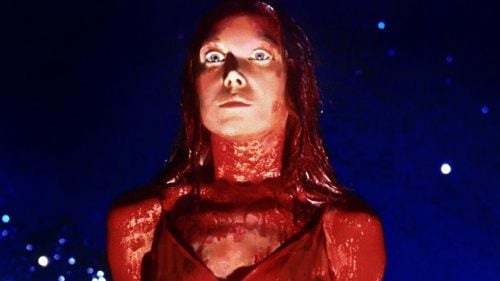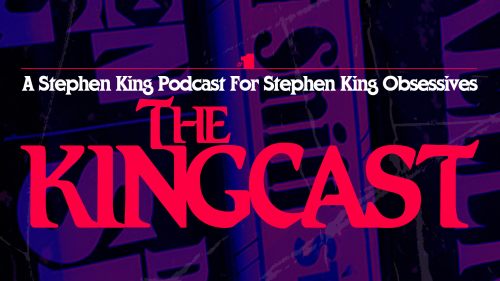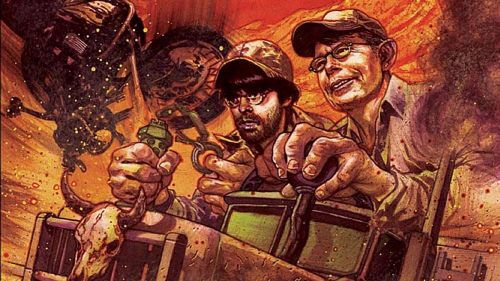John Carpenter’s CHRISTINE Is GREASE In Hell
An engine revs, and George Thorogood’s “Bad to the Bone” plays. It’s Detroit, 1957. Beige Plymouth Furys roll down an assembly line, and a single gleaming red car stands out among them. A worker pops the red car’s hood, a violation, and she slams it down on his hand. Another man makes the mistake of ashing his cigar on her seats. He doesn’t leave the car alive.
This is Christine’s birth. In one of his taped conversations with Truffaut, Hitchcock said he’d wanted to include a scene in North by Northwest where Roger Thornhill speaks to a factory worker as they walk along an assembly line. Behind them, two other workers build a car from start to finish. And when they’re done, they open the car door, and a corpse falls out. John Carpenter borrowed Hitchcock’s scrapped idea to introduce us to Christine. In Stephen King’s novel, Christine is haunted by the ghost of its previous owner Roland LeBay. But John Carpenter’s Christine was born bad.

Christine is a film about a killer car. It’s also a critique of capitalism and consumerism, an indictment of nostalgia and longing for the “good old days,” a story about toxic relationships and toxic masculinity, a twisted coming-of-age tale. It’s a horror film, a dark comedy, an erotic thriller with a car as its star. It can even be read as a rape-revenge film or a metaphor for addiction. Screenwriter Bill Phillips said Christine was “a story about your possessions possessing you.”
While Carpenter recovered from the critical and box-office failure of The Thing, his next project Firestarter fell through, so he took the next job that came his way. In an interview with Lee Gambin for The Making of Christine: Hell Hath No Fury Like Her, Carpenter explained his decision to adapt King’s novel: “When I get asked what attracted me to directing Christine, my answer is always this: I needed a job!” Though John Carpenter made the film out of necessity, nothing about Christine feels perfunctory. Christine is a classic, a horror masterpiece, and an undervalued entry in Carpenter’s filmography.
Christine is about a ’58 Plymouth Fury and a teenager named Arnie Cunningham (Keith Gordon). Arnie’s introduction is significantly less dangerous and exciting than Christine’s: his domineering mother gives him yogurt for lunch, he drops garbage in their driveway. Arnie’s unpopular, awkward, and regarded by his handsome quarterback friend Dennis Guilder (John Stockwell) as a terminal virgin. At school, he feels invisible and inconsequential.

Arnie and Christine are both broken down when they meet - Christine is rusted and neglected, and Arnie’s bruised, his glasses taped together after a demoralizing encounter with school bullies. Christine is “just as ugly as he is,” someone “who can be saved,” and Arnie relates. It’s love at first sight. Arnie restores Christine to her former glory, and in turn, Christine transforms Arnie into someone who epitomizes ‘50s macho cool. Slowly but surely, Christine reveals her malevolence: not only does she wreak havoc in Arnie’s relationships with new girl Leigh Cabot (Alexandra Paul) and his best friend Dennis, she also just straight-up murders people.
Christine is a femme fatale, drawing men to their doom. This film can be read as a story about toxic masculinity, but it’s also about toxic relationships. Arnie explains to Dennis: “Let me tell you a little something about love, Dennis. It has a voracious appetite. It eats everything. Friendship. Family. It kills me how much it eats. But I’ll tell you something else. You feed it right, and it can be a beautiful thing and that’s what we have.” But what Arnie feeds isn’t love. His relationships with Dennis and Leigh are healthy, loving, supportive, whereas his relationship with Christine doesn’t just take over his life, it destroys all other relationships. Carpenter chooses to keep her in frame even when she doesn’t need to be, and she seems to haunt the screen. Her toxic influence is an inexplicable, supernatural force. In short, it’s a possession.
Sadness and loneliness still underlie Arnie’s newfound machismo. He’s never a villain, just a tragic antihero, a boy caught in two love triangles: between Dennis and Christine and between Leigh and Christine. He ultimately chooses an unhealthy relationship over his healthy relationships, seduced by darkness, by all that the car represents: excess, status, machismo, power, destruction, the death drive, and nostalgia.

Christine is a horror film about nostalgia embodied by a ’58 Plymouth Fury. Between films like American Graffiti and Grease and groups like Sha Na Na, nostalgia for the ‘50s was omnipresent in the ‘70s. The film feels like it could exist in either decade, with its ‘70s covers of ‘50s songs and Arnie Cunningham’s evolution from ‘70s geek to James Dean in Rebel Without a Cause. Christine is basically Revenge of the Nerd, as if JG Ballard penned an ‘80s teen sex-comedy for degenerates.
More than that, Christine feels like a darkly comic horror-satire of Grease (1978) or Happy Days (1974 - 1984). The ‘50s they depicted are inaccurate - they’re a facsimile of the past. Carpenter wanted to create a “sense of a fabricated and almost dreamlike suburbia” in Christine: Rockbridge is another imaginary haven not unlike Halloween’s Haddonfield or the settings of Grease and Happy Days. Christine expresses herself by playing ‘50s hits on her radio, often as she kills people. (Robert & Johnny’s “We Belong Together” plays as Leigh chokes, and Thurston Harris’s “Little Bitty Pretty One” mocks Moochie as Christine runs him down.) The final song Christine plays is “Rock and Roll Is Here to Stay,” a song originally released by Danny and the Juniors in 1958 - and used again in Grease.
Like Arnie, Kenickie in Grease also finds a car that looks like it belongs in a junkyard and must convince his pals that it’s worth salvaging. The T-Birds sing “Greased Lightnin’” while they lovingly restore a car in a heavenly white garage. Carpenter even cast William Ostrander as bully Buddy Repperton because he resembled John Travolta. A scene where Buddy and his gang of greaser-bullies destroy Christine reads like a rape. (The bit of Carpenter’s and Alan Howarth’s score that plays is even called “The Rape.”) If the “Greased Lightnin’” sequence feels like it takes place in heaven, then this scene feels like Grease cast down into hell.

1988’s They Live was Carpenter’s most fully realized polemic against Reagan’s America, but the same attitude creeps into Christine, too. In an interview with Alissa Wilkinson, film critic J. Hoberman says, “Reagan rode in on a wave of nostalgia.” Reagan was in office while ’50s nostalgia was in full swing and films like Back to the Future were being released; in the meantime, Carpenter made subversive movies like The Thing, Escape from New York, and Christine. Hoberman suggests that Reagan’s rise to the presidency was a symptom of something. Just like ‘50s nostalgia in ‘70s and ‘80s movies, he fulfilled a reactionary need. Carpenter’s skewering of nostalgia in Christine was necessarily political - this inability to let go of the past brought us Reagan, who represented a longing for a golden age that never was.
Christine exposes “the good old days” for what they really were. The ‘50s gave us a booming economy, the growth of the suburbs, and the birth of rock ’n’ roll. But it was a cruel, repressive, paranoid, backward decade, an era of McCarthyism, the Cold War, the Korean War, rampant discrimination and segregation, a time defined by prejudice. And the poisonous ghost of the ‘50s lives on in Christine. Christine transforms Arnie into “Mr. Cool,” but he loses his humanity in the process, a Faustian bargain. Like the good old days, Christine appears glossy and beautiful on the surface - but she’s nothing but hollow malevolence on the inside, something best left in the scrap heap.



